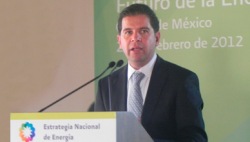Nuclear and wind to partner for Mexico
02 March 2012
Mexico has announced energy goals for 2026 that would see a combination of nuclear and wind power make up 23% of electricity. At the same time it wants to connect the entire population to the grid, decrease transmission losses and develop abundant shale gas reserves.
 |
| Jordy Herrera explains his plans |
Energy minister Jordy Herrera publicly presented the government's national energy strategy yesterday in Mexico City. Top of his priority list was to strengthen the hydrocarbon sector by increasing production of natural gas by 73% and characterising shale gas reserves fast enough to maintain a steady reserve.
Last year saw 258,128 GWh of electricity produced in Mexico, with about 10,000 GWh of this coming from nuclear. By 2026 the total amount of electrical power used is foreseen as some 479,650 GWh. Apart from 4% nuclear and the hydro sector that generates about 10% of electricity, Mexico's power mix is fossil-heavy: coal provides 12.5%; oil, 20%; and gas already some 49%.
But Mexico does not want to rely too much on gas: Some 35% of electricity is wanted to come from non-fossil sources, up from 20% now. However, hydro, biomass and solar can only expand to keep pace with growth in demand, leaving nuclear and wind as the only options to meet this goal. Three different scenarios were put forward where the the two favoured low-carbon technologies divide up a 23% share of electricity supply.
The most pessimistic scenario for nuclear sees it meeting 2.5% of demand, which at about 11,991 GWh represents virtually no growth on the country's only nuclear power plant, Laguna Verde, which hosts two boiling water reactors producing about 800 MWe each and licensed to operate until 2029 and 2034.
The middle scenario puts nuclear at 6.6%. This would be a tripling from current production to 31,656 GWh and would require a little over 4 GWe of nuclear capacity in total, assuming a capacity factor of 90%.
The last scenario has 18.1% of power coming from nuclear plants - some 86,816 GWh and about equivalent to the output from 11 GWe of nuclear generating capacity.
The new energy strategy document made note of last year's Fukushima accident and stressed Mexico's involvement in international forums to secure on-going improvement of nuclear safety. It said nuclear power 'continues to be a viable option to meet growing demand for energy' and noted it as 'among the best options' for power generation thanks to low external costs and minimal damage to public health and the environment.
Nuclear renaissance
Mexico had long-prepared nuclear expansion plans beyond its single Laguna Verde plant, but these faltered in recent years and looked unlikely to resurface given discovery of large reserves of shale gas.
Yesterday's policy document, however, explained that the government will develop a specific program, through the coordinated efforts of the Federal Electricity Commission, the National Institute of Nuclear Research, National Commission of Nuclear Safety and Safeguards and the US-based Electric Power Research Institute to develop a safe and competitive route for nuclear development. They will 'conduct studies to determine the financial, political and social viability, as well as the environmental implications of the gradual incorporation of new nuclear power plants.'
It was noted that nuclear developments have long lead times, and the definition of these projects would need to be agreed quickly. There will also be an effort, the government said, to engage in dialogue with local governments to reach consensus on the possibility of new nuclear.
Emissions set to rise
Apart from building new power plants, Mexican plans also call for increases in energy efficiency of 15% by 2026. In parallel it wants to make better use of existing power plants by reducing losses in the grid from some 17.3% last year to more like 8.0% in 2026. Achieveing that would allow Mexico to reduce its reserve margin in generation from 26.0% to 12.9%, said the government.
Nevertheless, the sheer growth in energy demand from all sectors will see carbon dioxide emissions rise by 40% to 567 million tonnes per year. The business-as-usual projection was for 52% growth to 619 million tonnes per year.